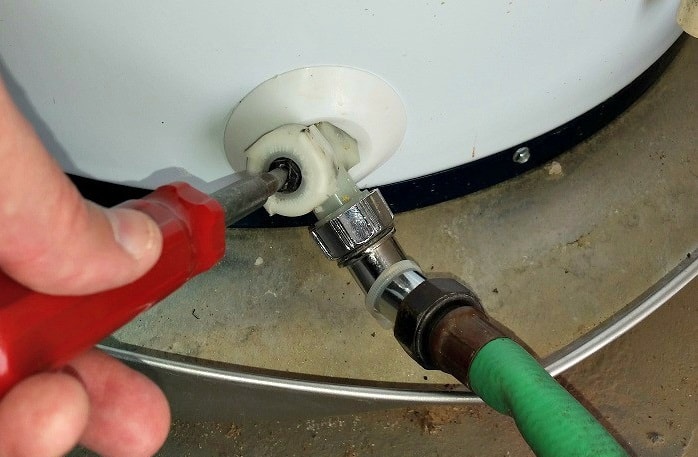Draining your water heater at least once a year is an important part of your home’s maintenance. Overtime, settlement can accumulate inside of your unit and damage interior components such as the heating elements. Settlement can stick to the heating elements which can reduce heat transfer and the efficiency of your unit.
What you will need:
- Flat blade screw driver
- Garden hose
- Knee-high stocking (optional)
- Rubber band or wire tie (optional)
Step 1: Turn off the power to the water heater at the circuit breaker.
Water heaters should have a dedicated breaker inside of the electrical panel. To turn the breaker off, simply move the breaker to the “off” position. For gas water heaters, turn the gas supply off.
Step 2: Fasten a garden hose to the drain valve.
Securely fasten a garden hose to the drain valve located at the bottom of the water heater. Extend the other end of the hose to the exterior or the nearest floor drain.
Step 3: Close the shut off valve at the cold water inlet line or main water supply.
The shut off valve for the cold water inlet is typically located right above the water heater. The water supply can also be closed at the main water line. Closing these valves will prevent the water heater from filling with water while you drain it.
Step 4: Open a hot water faucet somewhere in the home.
Opening a hot water faucet in the home will relieve the system pressure inside of the tank. The location of the faucet is not important, any hot water faucet will work.
Step 5: Open the drain valve and allow the water to drain.
Using a flat head screwdriver, open the drain valve by turning it counterclockwise. Caution: before turning on the drain valve, make sure no one will be exposed to the hot water released by the valve. The water inside the tank can exceed 125 degrees Fahrenheit and can cause severe burns, especially in young children.
Optional: Tie a knee high stocking to the end of the garden hose determine the amount of sediment captured. The amount of sediment can help you determine how often to drain your water heater. If you notice lot of sediment, consider draining your water heater more often. Areas with high levels of calcium and metals in the water will have greater amounts of sediment.
Step 6: When the water stops, remove the garden hose, open a hot water faucet, and open the shut off valve located at the cold water inlet line or main water supply.
When water stops draining, remove the garden hose attached to the drain valve. Next, open a hot water faucet anywhere in the home and open the cold water supply valve. At this point, you should hear the water heater fill with water. When you have a steady stream of water coming from the open hot water faucet, turn the faucet off.
Step 7: Turn the electric power back on at the circuit breaker.
To turn the power back on, locate the water heater breaker and move it to the on position. For gas water heaters, turn the gas supply back on. Finally, double check the drain valve is tightly closed.
Follow these simple steps to drain your water heater. To schedule an inspection, call us at 813-261-0002 or visit our website at https://homecheckfl.com

